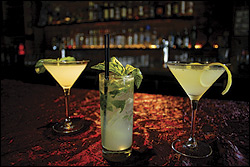Historically, gin has had a rough ride. It came to England in 1689 along with the Dutch stadhouder William of Orange when he arrived from Holland to ascend the English throne. He promptly declared war on France and banned her products, including wine and brandy. In 1690, he persuaded Parliament to pass “an act for encouraging the distilling of brandy and spirits from corn” to create a homegrown distilling industry to replace French spirits.
The floodgates were wide open, and supplies of gin were plentiful and inexpensive. Gin (short for Geneva, the Dutch name for the juniper berry used to flavor it) was easy to make and cheap. While beer taverns were restrained by licenses and limited hours of operation, practically anybody could sell gin out of a back room. So gin rapidly became the favored drug of abuse among the city slums, vilified then and (off and on) ever since as the poison of the poor.
Although many kinds of spirits were consumed avidly during Prohibition, gin was again the favorite—cheap, easy to make, and, unlike even bad whiskey, requiring no barrel aging. But at the end of Prohibition, gin fell victim to a bad image (“bathtub gin”) and a shift in public taste toward lighter, less complex flavors. After World War II, gin’s decline continued. “The ’60s were a time of change,” says Dale DeGroff, (author of the definitive Craft of the Cocktail). “Younger people didn’t drink many stronger spirits, and they had plenty of other stuff to do.” Then came vodka. “The whole Smirnoff saga had a lot to do with it. It was marketed so beautifully and mixed so well with so many things,” says DeGroff. By 1976, it was the most consumed distilled spirit in America.
Now that “flavored spirits” have made such headway with young drinkers, gin ought to be well positioned for a comeback. Gin isn’t just juniper-flavored alcohol—while juniper may be the main flavor component, every brand uses its own special assortment of botanicals, including coriander seed, aniseed, caraway, ginger, cumin, and lemon and orange peel, among others. (Superpremium Hendricks Gin from Scotland boasts of using cucumber and rose petals in its formula.) But marketers are still struggling with the spirit’s outdated reputation.
There are three main styles of gin: Holland, London Dry, and Plymouth. “Holland gin is made from barley and malt. You’d never find it in a dry martini because it tastes barley-malty,” explains DeGroff. (Bols is one of the few Dutch gins to be found stateside and is not particularly popular.) London Dry gins tend to have a stronger juniper flavor and are often spicy. “Bombay, Boodles, Tanqueray, and Beefeater are your traditional London Dry style,” says DeGroff, best suited to use in dry martinis. For juicer cocktails, he recommends using Tanqueray No. Ten or Plymouth. “Tanqueray Ten is totally different stylistically, as it’s built to appeal to a younger audience because a lot of citrus is used in it.”
The Plymouth style is softer, with citrus and floral notes. It wasn’t always so. Plymouth was the home harbor of the British navy, and where the navy went, gin went. Legend has it that naval gin was 114 proof (you could always add water), and that sailors poured gin over gunpowder to see if it was really 114 proof—if it still burned, it was up to snuff.
New gins continue to trickle into the market. Tanqueray No. Ten and Hendricks were both launched in 2000, and locally produced gins, like Oregon’s Medoyeff’s winter gin, are slated to hit the Seattle market late this year. (It’s already available through the liquor store by special order.)
Though new brands temporarily pump up excitement, gin still faces an uphill battle in a market where fruity vodka-based drinks are all the rage. “Gin is a more complex, subtle flavor [than other white spirits],” says Devlin McGill, an owner of the Great Nabob bar in Queen Anne. What’s more, “James Bond added to the decline of gin martinis [by ordering his to be made with vodka]. Every man in America wanted to be James Bond.” In order to draw attention to gin drinks beyond the martini and gin and tonic, McGill tries to list some unusual gin cocktails on his menu. One of the drinks he says he is most proud of is the Basil Collins ($6), made with Bellringer (his well gin), lemon juice, and simple syrup muddled with basil.
The Great Nabob also offers the Southside ($7), which McGill describes as a gin mojito, made with Bellringer, mint, lemon juice, and sugar; and the Seventh Heaven ($7), which incorporates clear Maraska maraschino liqueur and grapefruit juice. McGill explains that all these drinks “can be made with other gins for somebody who is experimenting a little bit with gin.”
Experimentation is what it’s about. “Gin is probably the easiest transition booze from vodka,” notes McGill, who adds that it’s the bartenders’ responsibility to “educate other bartenders that there’s something else out there besides vodka.” Converting customers can be as simple as offering a new gin-based cocktail when they tire of lemon drops. “Then they have tasted the Southside and they are in love with it. All the old bad perceptions of gin have gone out the door.” McGill concludes “You win them over to gin, and they are yours.” Maybe there’s still hope for history’s much-maligned and truly original flavored spirit.





